A few of months back, I was asked to put together an article on spinning bamboo. It appears it will not be used for its originally intended purpose, so I’m posting it here… even though it may look a little out of sequence with some of my other posts.
What is bamboo? My first thought upon undertaking an article about spinning Merino-Bamboo blends was, “What is this stuff?” Of course, I know what bamboo is. It’s a plant that pandas eat, of course, just like eucalyptus is a plant that koalas eat. I know these things. However, my experience with bamboo products would imply that harvested bamboo is not something one would wear, but somewhat stiff and perhaps suitable for making furniture or picture frames… more like wood, in fact. The picture in my mind does not have a soft fluffy payload provided by a pod on the end of the plant, the way cotton does. So, how do they make bamboo into fiber?
A quick Internet search turned up a vast amount of material. (1) (2) (3) Basically, bamboo is mashed and processed and squeezed out into filaments, which it occurs to me is a bit like making sausage. Processing the filaments extremely fine creates a soft, almost silky, fiber. The product carries various monikers, including “Rayon,” “Rayon Viscose,” “Bamboo Viscose,” “Viscose from Bamboo,” or, more simply, “Bamboo Fiber.”
Much debate exists regarding the environmental impact of Bamboo Viscose production, including the sustainability of cutting the bamboo plants as well as the chemicals used in processing and their by-products. For every article I found advocating for bamboo, I found another detractor. I also noted comparisons to the processing of cotton as well as superwash wool, two spinning fibers whose production has both similarities and differences to bamboo processing. I enjoyed an article in the Dolce Handknits blog regarding superwash wool. Her point about the smell of new shoes puts it in perspective. I have not eschewed sneakers, yet, either. Each fiber artist can only make these decisions for him- or herself.
The more commonly available bamboo blends for spinning are “Panda,” a blend of Merino / Bamboo / Nylon, 60 / 30 / 10 (listed as “percent, respectively”), and Merino / Bamboo which may be either 60 / 40 or 70 / 30 Merino / Bamboo, sometimes sold as “Meriboo." Certainly, 100% bamboo can be spun as well, as Amy Singer reviewed in Knitty.
In selecting bamboo blends to spin, the first thing I noticed was the somewhat muted color. The bamboo does not absorb the dye quite the way that wool does, so a wool/bamboo blend has lighter filaments running through it. One of the fibers I selected was Panda by Fat Cat Knits in the colorway “Wizard Island.” The Fat Cat Knits web site shows each colorway on different fibers, which is a quick way to see the “muted” difference of using the same color on a bamboo blend.
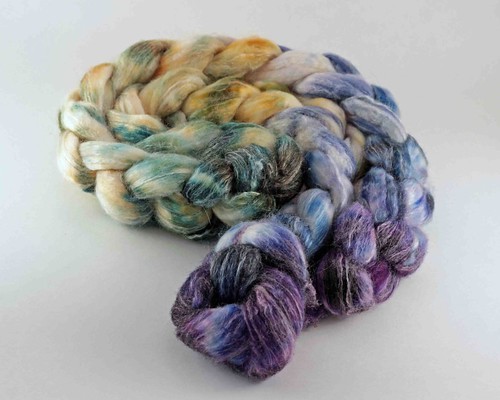 The “Wizard Island” colorway provides two repeats of a long gradient, starting at purple on one end, blending through blue, yellow, and green in the middle of the braid, and then blending back through the same color changes to return to purple on the other end. I divided the fiber in half at the green point, leaving me with two pieces the same length, each with the same color progression. My plan was to spin each piece in one long length, and then chain-ply (also known as Navajo Plying), to maintain the color progression. By having two pieces the same, I could make two matching socks. To prep the fiber, I pre-drafted along the length, coiling up pieces short enough to manage, and placing them in a row, one half-braid per basket.
The “Wizard Island” colorway provides two repeats of a long gradient, starting at purple on one end, blending through blue, yellow, and green in the middle of the braid, and then blending back through the same color changes to return to purple on the other end. I divided the fiber in half at the green point, leaving me with two pieces the same length, each with the same color progression. My plan was to spin each piece in one long length, and then chain-ply (also known as Navajo Plying), to maintain the color progression. By having two pieces the same, I could make two matching socks. To prep the fiber, I pre-drafted along the length, coiling up pieces short enough to manage, and placing them in a row, one half-braid per basket.
 I began spinning worsted, and I found the slipping of the fibers to be a bit inconsistent, requiring a little more attention than some wools to keep them in line. While it was a bit “fiddly,” it was not unmanageable. I enjoyed the spin more, though, once I switched to a woolen spin. I took the pre-drafted fibers in pieces, tearing off one chunk at a time, in color order, and spinning from the fold. In general, I found the spin to be not significantly different than spinning with a wool / silk blend. The chain-plying resulted in two skeins of approximately 140 yards each, 18-20 wpi, ready to make socks.
I began spinning worsted, and I found the slipping of the fibers to be a bit inconsistent, requiring a little more attention than some wools to keep them in line. While it was a bit “fiddly,” it was not unmanageable. I enjoyed the spin more, though, once I switched to a woolen spin. I took the pre-drafted fibers in pieces, tearing off one chunk at a time, in color order, and spinning from the fold. In general, I found the spin to be not significantly different than spinning with a wool / silk blend. The chain-plying resulted in two skeins of approximately 140 yards each, 18-20 wpi, ready to make socks.
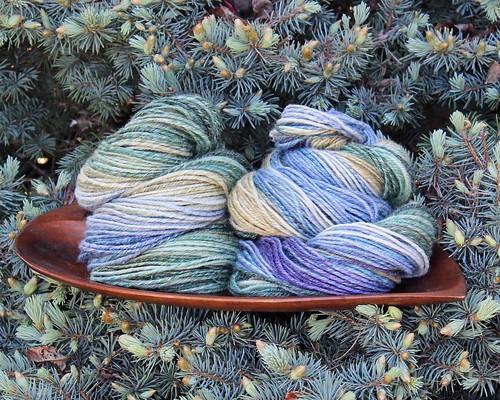 The gradient may not be readily apparent in the skeined yarn, but it becomes quite obvious when the yarn is caked into center-pull balls.
The gradient may not be readily apparent in the skeined yarn, but it becomes quite obvious when the yarn is caked into center-pull balls.
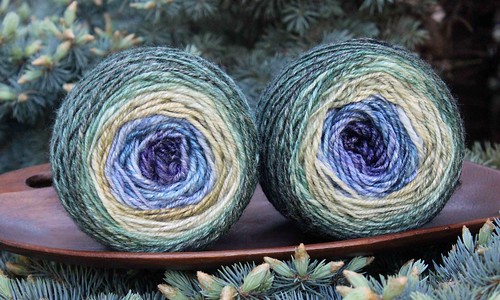 In making socks, I cast on at the toe with Judy’s Magic Cast On and then used my favorite sock recipe, David’s Toe-Up Sock Cookbook to start my sock. I say “to start” because I like to use the recipe to get stitch count from an arbitrary gauge, but I usually replace the heel when I am using yarn thicker than fingering. The recipe provides a heel-flap heel, and I find that it becomes too bulky in heavier yarns. I like to use the “gusset heel” from “Socks From the Toe Up” by Wendy D Johnson of Wendy Knits. The gusset heel looks a bit like a short row heel, but I find it much simpler. Simple is good!
In making socks, I cast on at the toe with Judy’s Magic Cast On and then used my favorite sock recipe, David’s Toe-Up Sock Cookbook to start my sock. I say “to start” because I like to use the recipe to get stitch count from an arbitrary gauge, but I usually replace the heel when I am using yarn thicker than fingering. The recipe provides a heel-flap heel, and I find that it becomes too bulky in heavier yarns. I like to use the “gusset heel” from “Socks From the Toe Up” by Wendy D Johnson of Wendy Knits. The gusset heel looks a bit like a short row heel, but I find it much simpler. Simple is good!
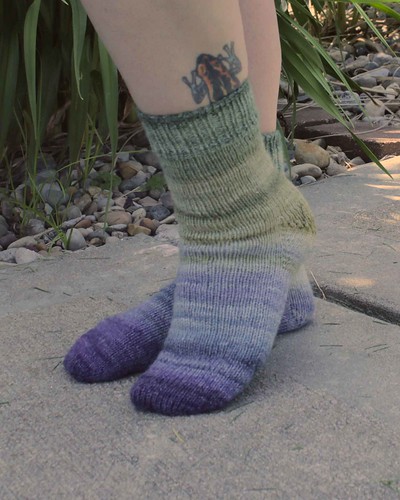

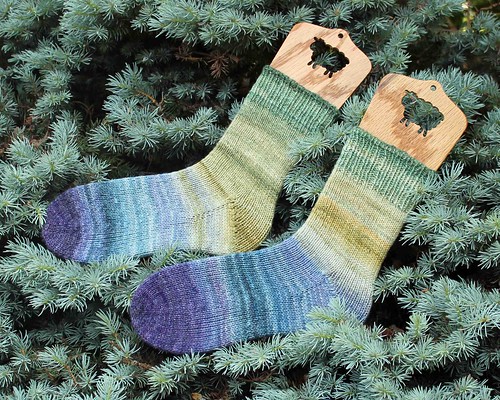 The nylon content of the Panda lends itself well to use in socks, helping provide strength and avoid wearing them through. I reached my desired sock height well before using up all the yarn, so the darkest green does not appear in the socks.
I also wanted to try a Meriboo blend, and I selected a 60 / 40 blend from Knitty and Color in the colorway “Aqua Blue.” The “muted” way the bamboo fiber takes up dye lends itself very well to semi-solid colorways, providing an extra depth to the color variation.
The nylon content of the Panda lends itself well to use in socks, helping provide strength and avoid wearing them through. I reached my desired sock height well before using up all the yarn, so the darkest green does not appear in the socks.
I also wanted to try a Meriboo blend, and I selected a 60 / 40 blend from Knitty and Color in the colorway “Aqua Blue.” The “muted” way the bamboo fiber takes up dye lends itself very well to semi-solid colorways, providing an extra depth to the color variation.
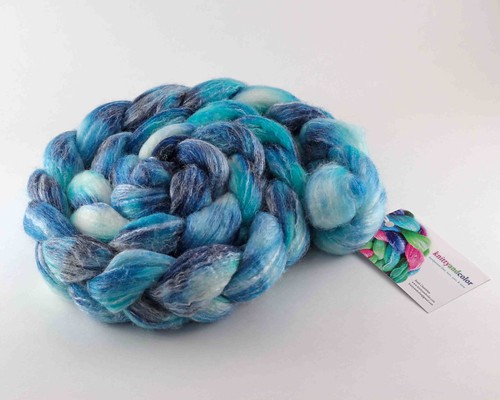 I prepped for a woolen spin, making faux-lags directly from the braid.
I prepped for a woolen spin, making faux-lags directly from the braid.
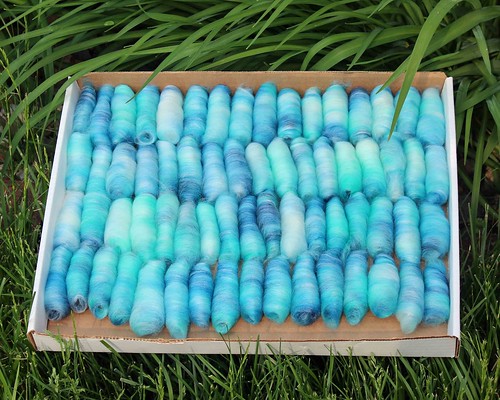 I spun two bobbins and plied them together for a simple-two ply yarn, yielding approximately 300 yards, 16 wpi.
I spun two bobbins and plied them together for a simple-two ply yarn, yielding approximately 300 yards, 16 wpi.
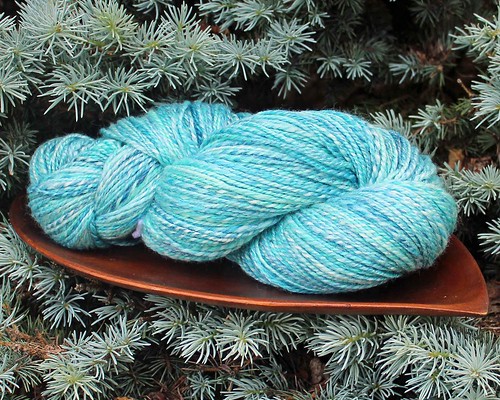 I used the “Aqua Blue” yarn as weft in a scarf, weaving it with some leftover sock yarn. I warped rather close together, using a double heddle, two 10 epi heddles, to achieve 20 epi.
I used the “Aqua Blue” yarn as weft in a scarf, weaving it with some leftover sock yarn. I warped rather close together, using a double heddle, two 10 epi heddles, to achieve 20 epi.
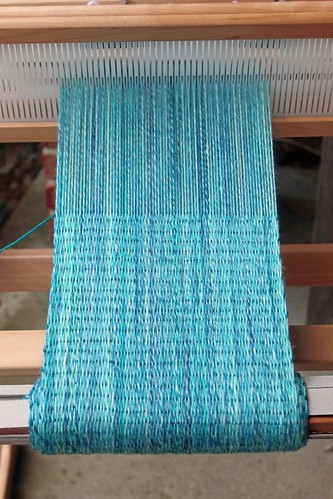 The resulting warp-faced weave hides most of the sock yarn, letting the bamboo yarn colors dominate. The long runs in the yarn, lengthwise in the scarf, really allow the color variation in the bamboo handspun to show off.
The resulting warp-faced weave hides most of the sock yarn, letting the bamboo yarn colors dominate. The long runs in the yarn, lengthwise in the scarf, really allow the color variation in the bamboo handspun to show off.
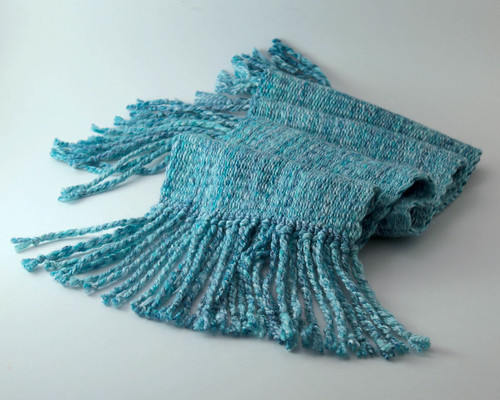 I enjoyed spinning the bamboo. The results are a bit firmer than 100% wool, just as I have found with silk blends. With or without the added nylon, the Bamboo provides a bit of a reinforcing element, especially nice for socks, and has sheen similar to silk.
Happy Knitting,
Lisa Kay
I enjoyed spinning the bamboo. The results are a bit firmer than 100% wool, just as I have found with silk blends. With or without the added nylon, the Bamboo provides a bit of a reinforcing element, especially nice for socks, and has sheen similar to silk.
Happy Knitting,
Lisa Kay
 The “Wizard Island” colorway provides two repeats of a long gradient, starting at purple on one end, blending through blue, yellow, and green in the middle of the braid, and then blending back through the same color changes to return to purple on the other end. I divided the fiber in half at the green point, leaving me with two pieces the same length, each with the same color progression. My plan was to spin each piece in one long length, and then chain-ply (also known as Navajo Plying), to maintain the color progression. By having two pieces the same, I could make two matching socks. To prep the fiber, I pre-drafted along the length, coiling up pieces short enough to manage, and placing them in a row, one half-braid per basket.
The “Wizard Island” colorway provides two repeats of a long gradient, starting at purple on one end, blending through blue, yellow, and green in the middle of the braid, and then blending back through the same color changes to return to purple on the other end. I divided the fiber in half at the green point, leaving me with two pieces the same length, each with the same color progression. My plan was to spin each piece in one long length, and then chain-ply (also known as Navajo Plying), to maintain the color progression. By having two pieces the same, I could make two matching socks. To prep the fiber, I pre-drafted along the length, coiling up pieces short enough to manage, and placing them in a row, one half-braid per basket.
 I began spinning worsted, and I found the slipping of the fibers to be a bit inconsistent, requiring a little more attention than some wools to keep them in line. While it was a bit “fiddly,” it was not unmanageable. I enjoyed the spin more, though, once I switched to a woolen spin. I took the pre-drafted fibers in pieces, tearing off one chunk at a time, in color order, and spinning from the fold. In general, I found the spin to be not significantly different than spinning with a wool / silk blend. The chain-plying resulted in two skeins of approximately 140 yards each, 18-20 wpi, ready to make socks.
I began spinning worsted, and I found the slipping of the fibers to be a bit inconsistent, requiring a little more attention than some wools to keep them in line. While it was a bit “fiddly,” it was not unmanageable. I enjoyed the spin more, though, once I switched to a woolen spin. I took the pre-drafted fibers in pieces, tearing off one chunk at a time, in color order, and spinning from the fold. In general, I found the spin to be not significantly different than spinning with a wool / silk blend. The chain-plying resulted in two skeins of approximately 140 yards each, 18-20 wpi, ready to make socks.
 The gradient may not be readily apparent in the skeined yarn, but it becomes quite obvious when the yarn is caked into center-pull balls.
The gradient may not be readily apparent in the skeined yarn, but it becomes quite obvious when the yarn is caked into center-pull balls.
 In making socks, I cast on at the toe with Judy’s Magic Cast On and then used my favorite sock recipe, David’s Toe-Up Sock Cookbook to start my sock. I say “to start” because I like to use the recipe to get stitch count from an arbitrary gauge, but I usually replace the heel when I am using yarn thicker than fingering. The recipe provides a heel-flap heel, and I find that it becomes too bulky in heavier yarns. I like to use the “gusset heel” from “Socks From the Toe Up” by Wendy D Johnson of Wendy Knits. The gusset heel looks a bit like a short row heel, but I find it much simpler. Simple is good!
In making socks, I cast on at the toe with Judy’s Magic Cast On and then used my favorite sock recipe, David’s Toe-Up Sock Cookbook to start my sock. I say “to start” because I like to use the recipe to get stitch count from an arbitrary gauge, but I usually replace the heel when I am using yarn thicker than fingering. The recipe provides a heel-flap heel, and I find that it becomes too bulky in heavier yarns. I like to use the “gusset heel” from “Socks From the Toe Up” by Wendy D Johnson of Wendy Knits. The gusset heel looks a bit like a short row heel, but I find it much simpler. Simple is good!


 The nylon content of the Panda lends itself well to use in socks, helping provide strength and avoid wearing them through. I reached my desired sock height well before using up all the yarn, so the darkest green does not appear in the socks.
I also wanted to try a Meriboo blend, and I selected a 60 / 40 blend from Knitty and Color in the colorway “Aqua Blue.” The “muted” way the bamboo fiber takes up dye lends itself very well to semi-solid colorways, providing an extra depth to the color variation.
The nylon content of the Panda lends itself well to use in socks, helping provide strength and avoid wearing them through. I reached my desired sock height well before using up all the yarn, so the darkest green does not appear in the socks.
I also wanted to try a Meriboo blend, and I selected a 60 / 40 blend from Knitty and Color in the colorway “Aqua Blue.” The “muted” way the bamboo fiber takes up dye lends itself very well to semi-solid colorways, providing an extra depth to the color variation.
 I prepped for a woolen spin, making faux-lags directly from the braid.
I prepped for a woolen spin, making faux-lags directly from the braid.
 I spun two bobbins and plied them together for a simple-two ply yarn, yielding approximately 300 yards, 16 wpi.
I spun two bobbins and plied them together for a simple-two ply yarn, yielding approximately 300 yards, 16 wpi.
 I used the “Aqua Blue” yarn as weft in a scarf, weaving it with some leftover sock yarn. I warped rather close together, using a double heddle, two 10 epi heddles, to achieve 20 epi.
I used the “Aqua Blue” yarn as weft in a scarf, weaving it with some leftover sock yarn. I warped rather close together, using a double heddle, two 10 epi heddles, to achieve 20 epi.
 The resulting warp-faced weave hides most of the sock yarn, letting the bamboo yarn colors dominate. The long runs in the yarn, lengthwise in the scarf, really allow the color variation in the bamboo handspun to show off.
The resulting warp-faced weave hides most of the sock yarn, letting the bamboo yarn colors dominate. The long runs in the yarn, lengthwise in the scarf, really allow the color variation in the bamboo handspun to show off.
 I enjoyed spinning the bamboo. The results are a bit firmer than 100% wool, just as I have found with silk blends. With or without the added nylon, the Bamboo provides a bit of a reinforcing element, especially nice for socks, and has sheen similar to silk.
Happy Knitting,
Lisa Kay
I enjoyed spinning the bamboo. The results are a bit firmer than 100% wool, just as I have found with silk blends. With or without the added nylon, the Bamboo provides a bit of a reinforcing element, especially nice for socks, and has sheen similar to silk.
Happy Knitting,
Lisa Kay
Comments